Black Russian Terrier History
The Black Russian Terrier, often called the “Blackie,” traces its roots back to post-World War II Russia. This breed wasn’t merely a result of natural selection but rather an intelligent design by the Soviet Red Army. They sought to create a powerful, fearless canine capable of performing various military tasks, from guarding to patrolling. The Black Russian Terrier’s lineage combines the robust genes of over seventeen breeds, including the Rottweiler, Giant Schnauzer, and the Airedale Terrier. Over time, this purposeful breeding produced a dog that was not only strong and resilient but also loyal and protective. Today’s Black Russian Terrier, while no longer serving military duties, continues to be a testament to its illustrious history.
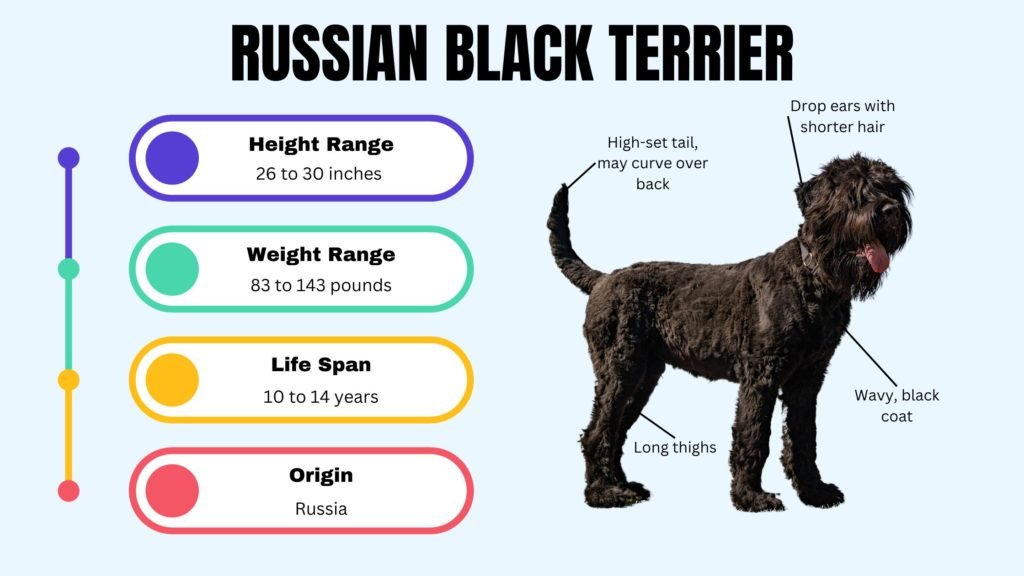
Black Russian Terrier Characteristics
Glancing at a Black Russian Terrier is enough to grasp its power and grace. Males stand tall at 27 to 30 inches, with females following closely at 26 to 29 inches. Their weight, ranging from 80 to an occasionally above-average 143 pounds, reinforces their strong and well-built stature. Their double coat is another remarkable feature, with a coarse outer layer and a soft, thick undercoat. This coat is predominantly black, but one might sometimes spot a sprinkling of gray, especially in puppies.
However, the Black Russian Terrier isn’t just about physical strength. Their health is generally robust, with a few conditions to watch out for, like hip dysplasia and Progressive Retinal Atrophy (PRA). These canines can lead a healthy life with proper care, regular check-ups, and a balanced diet of 3 to 4.5 cups of dry food daily.
Black Russian Terrier Personality
If you’ve ever observed a Black Russian Terrier, you’d first notice their calm confidence. They exude a certain tranquility due to their historically stable nervous systems. This emotional stability and their military background make them self-assured and loyal companions. However, they can be aloof with strangers—a trait not uncommon in many breeds.
I’ve always emphasized the importance of early socialization for any dog, and the Black Russian Terrier is no exception. Their natural tendency to guard and protect can quickly become overbearing if not appropriately channeled. Early exposure to different people, sights, and sounds ensures they grow well-rounded and more accepting of unfamiliar experiences. A well-socialized Black Russian Terrier is a joy to have around, especially if there are kids in the household. Their love for children and protective nature make them excellent family pets.
But, like humans, even the Black Russian Terrier seeks purpose. They thrive on firm direction and tasks. Being intelligent creatures, they respond well to training that incorporates positive reinforcement. Rewards, whether as treats, play, or simple praises, go a long way in establishing a trusting bond. Remember, these dogs are incredibly people-oriented. Neglecting them or relegating them to the backyard can result in a withdrawn Blackie, and that’s a situation no pet parent would want.
Black Russian Terrier Life Span
With its robust frame and inherent strength, the Black Russian Terrier has a life span matches its vitality. Generally, this breed can grace your life for 10 to 14 years with good care, proper nutrition, and regular health check-ups. Like any other dog, their longevity is influenced by genetics, diet, environment, and overall well-being. As an owner, you play a pivotal role in ensuring that your Black Russian Terrier enjoys not just a long life but a fulfilling one.
Black Russian Terrier Family Life
Blackies, as many affectionately call them, are genuinely family dogs. Their undying loyalty, combined with an innate love for children, makes them perfect family companions. They’re not just protectors but playmates, listeners, and cuddlers. Having been bred for their emotional stability, they often show a profound attachment to their human families. However, it’s vital to remember that they need consistent interaction while calm and serene. They thrive when they feel part of the family, sharing joys, sorrows, and everyday moments.
Black Russian Terrier Habitat and Diet
The Black Russian Terrier is adaptable in terms of habitat. While they can comfortably reside in apartments, the key lies in ensuring they get adequate exercise. They need their daily dose of mental and physical stimulation – a simple stroll in the park or a vigorous play session can work wonders. However, given their size and activity levels, a home with a fenced yard is ideal.
Diet plays an equally crucial role in their well-being. A Black Russian Terrier’s dietary needs can vary based on age, activity levels, and individual metabolism. Typically, 3 to 4.5 cups of high-quality dry food a day, divided into two meals, suffice. Being vigilant about their weight is essential. Regularly measuring their food and ensuring they don’t overeat is a straightforward way to keep them in shape.
Black Russian Terrier Temperament
The temperament of a Black Russian Terrier is a harmonious blend of confidence, calmness, and courage. Their history is deeply rooted in guarding and protecting, traits that they proudly carry even today. While they exude an air of self-assuredness, they are never overly aggressive without cause. This stable temperament, however, doesn’t negate the need for early and consistent training. A well-trained Blackie is a pleasure to be around – composed, responsive, and ever-watchful.
Black Russian Terrier Behavior with Other Animals
The Black Russian Terrier’s interactions regarding their behavior with other animals are nuanced. Early socialization plays a defining role. A Blackie introduced to various animals at a young age tends to be more accepting and less dominant. However, their protective instincts sometimes make them wary of unfamiliar animals, especially if they perceive them as threats. In multi-pet households, it’s not uncommon to find Blackies getting along well with other pets, primarily if they’ve been raised together. Still, supervision, especially in the initial stages of introduction, is always recommended. Understanding the unique personality of your Black Russian Terrier and the nature of the other animal is vital to fostering a harmonious relationship between them.
Black Russian Terrier Coat Color And Grooming
The Black Russian Terrier’s coat is one of its most defining features. Predominantly black, some might sport a sprinkling of gray hair, evident even in puppies. This double-coated breed boasts a coarse outer layer, while its undercoat remains soft and thick. The length varies between 1.5 to 4 inches, often giving it a tousled, sometimes curly, appearance.
For a Black Russian Terrier, grooming is about aesthetics, health, and comfort. A weekly brush with a slicker brush, undercoat rake, and a stripping comb can prevent matting and ensure their coat remains clean and tangle-free. While they aren’t heavy shedders, regular grooming sessions will minimize stray hairs around the house. Their facial hair, especially the beard, can retain water, so it’s advisable to give it some attention after drinks or damp outings.
Black Russian Terrier Health
Though robust and hardy, the Black Russian Terrier isn’t immune to health issues. Common concerns include allergies ranging from food to inhalant types. Hip dysplasia, a condition where the thighbone doesn’t snugly fit the hip joint, is another ailment to be aware of. Other concerns are elbow dysplasia and Progressive Retinal Atrophy (PRA). Routine vet check-ups, a balanced diet, and regular exercise can mitigate health risks, ensuring your Blackie remains optimal.
Black Russian Terrier Price
Owning a Black Russian Terrier is an investment, both emotionally and financially. Prices can vary depending on pedigree, breeder reputation, and location. As of my last update, puppies from reputable breeders can range from $1,500 to $3,500. It’s always advisable to prioritize health and temperament over cost. In the long run, a healthy, well-bred Black Russian Terrier is worth its weight in gold.
Black Russian Terrier Trainability
One of the most rewarding aspects of owning a Black Russian Terrier is their trainability. Their intelligence, combined with an eagerness to please, makes them relatively straightforward to train. However, the key lies in starting early. Their protective instincts can be strong, so early socialization and positive reinforcement training methods work best. Being consistent, firm, but gentle is the ideal approach. With guidance, Blackies can excel in various canine activities beyond basic obedience, including agility and therapy work.
Black Russian Terrier Care
Caring for a Black Russian Terrier goes beyond the basics of food, shelter, and health. These dogs crave companionship. They thrive when part of family activities and are not suited to long hours of isolation. Their diet should be high-quality, matching their age and activity levels. Mental stimulation is as crucial as physical exercise. Puzzle toys, training sessions, and interactive games can engage their active minds. Remember, a happy Black Russian Terrier feels loved, challenged, and integral to its family’s daily life.
Related Breeds
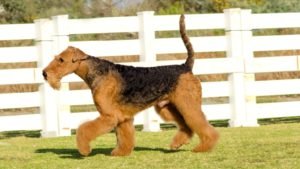
Airedale Terrier: The Vibrant City Companion
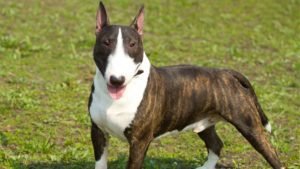
Bull Terrier: Passionate and Playful

Boston Terrier: The Elite Urban Companion
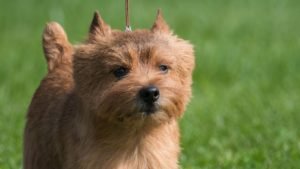
Norwich Terrier: Your Pocket-Sized Powerhouse
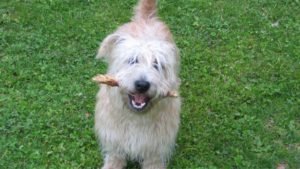
Glen of Imaal Terrier: A Tail of Tenacity and Love

Jack Russell Terrier: Pure Heart, Spirited Soul

Australian Silky Terrier: Thrive in their World

Biewer Terrier: Heartfelt and Genuine

Yorkshire Terrier: A Breed Apart

Norfolk Terrier: The Canine Icon
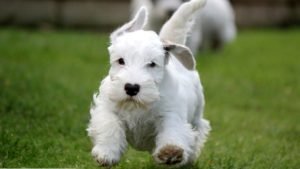
Sealyham Terrier: Boundless Affection
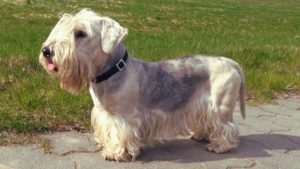
Cesky Terrier: The Canine Dynamo
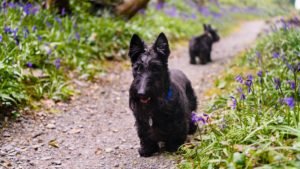
Scottish Terrier: Small in Size, Grand in Presence
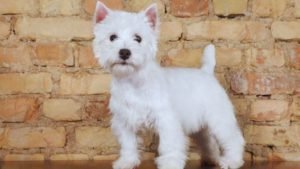
West Highland Terrier: A Bundle of Vigor and Joy

